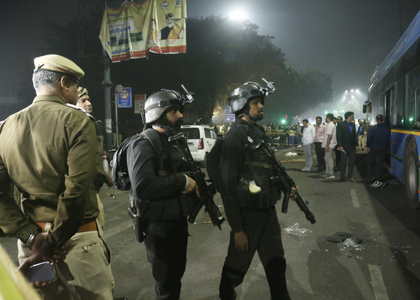Delhi blasts: Agencies track expanding money trail behind JeM’s Faridabad module, its Turkey handlers
By IANS | Updated: November 17, 2025 13:20 IST2025-11-17T13:19:34+5:302025-11-17T13:20:11+5:30
New Delhi, Nov 17 Investigators are digging into a money trail of Rs 20 lakh that reached one ...

Delhi blasts: Agencies track expanding money trail behind JeM’s Faridabad module, its Turkey handlers
New Delhi, Nov 17 Investigators are digging into a money trail of Rs 20 lakh that reached one of the members of the Faridabad terror module of the Jaish-e-Mohammad. The money was used solely for recruitment purposes, investigations have found.
Officials said that Rs 20 lakh was passed on to Dr. Shaheen Shahid, one of the top members of the module. Shaheen was in charge of recruitment and hence the money was handed over to her through a hawala channel.
The probe found that Shaheen operated seven bank accounts in Delhi, Lucknow and Kanpur. The account details are being investigated to find more details about the money trail.
The agencies are yet to establish where the money came from and for now they suspect that the funds could have flown in from either Jammu and Kashmir or some Gulf nation.
Investigators are also not ruling out the possibility of money being routed in from Turkey.
The Turkey visit by some of the module members is a key aspect to the probe. In March 2022 the members of this module travelled to Turkey and met with their handler Abu Ukasha, who investigators suspect is an ISI asset.
Intelligence Bureau officials say that he is a Pakistan-based intermediary who was moved to Turkey to coordinate with this module.
Officials say that Abu Ukasha is his code name which he used during covert operations. Investigations have found that during the Turkey visit, Ukasha is said to have given instructions to the module to carry out the blast on December 6, 2022.
However, the plan kept getting postponed for some reason or the other.
The probe agencies have been able to by and large establish that Shaheen was fully in charge of the recruitment. This is why chasing the money trail and investigating her seven bank accounts becomes extremely important. The money trail could well lead us up to Pakistan, officials explained.
In addition to tracing the trail of the Rs 20 lakh that was used for recruitment, the agencies are also trying to find out about the flow of the remaining funds.
The National Investigation Agency (NIA) and Enforcement Directorate (ED) have learnt that Rs 3 lakh had been used to purchase 2,600 kgs of ammonium nitrate.
Officials say that Shaheen was recruited to the module by Maulvi Irfan Ahmed who hails from Jammu and Kashmir. He had ordered that the Rs 20 lakh meant for recruitment be handled by Shaheen entirely.
However this did not go down well with Delhi bomber Dr. Umar Nabi and there was apparently a financial dispute between them.
Ahmed was aware that Shaheen, who went off the radar in 2013, was in touch with a doctor abroad. It that he who radicalised her and even introduced her to Ahmed.
The doctor would send her propaganda material and completely used her vulnerability to radicalise her. Shaheen had become extremely reserved post a very difficult divorce and this doctor abroad who knew her took complete advantage of her situation.
Later on Shaheen stayed in touch with Ahmed, who in turn tasked her with overseeing the formation of the Faridabad module.
She managed to recruit many into the module, but what impressed her bosses is that a majority of those she picked were doctors. She was the one who recruited the bomber Nabi and another Kashmiri doctor Dr. Muzammil Ahmad Ganaie.
She had convincing skills and hence she was asked to take charge of the recruitments and also manage the funds allocated for this purpose.
There are multiple agencies at work investigating this case. Officials say that while all aspects of the probe are important tracking the money trail is of utmost importance.
This will also help the agencies ascertain whether more money had come in to set up other modules in the country. The Jaish-e-Mohammad had planned big modules across the country and wanted to follow the Faridabad model.
Disclaimer: This post has been auto-published from an agency feed without any modifications to the text and has not been reviewed by an editor
Open in app